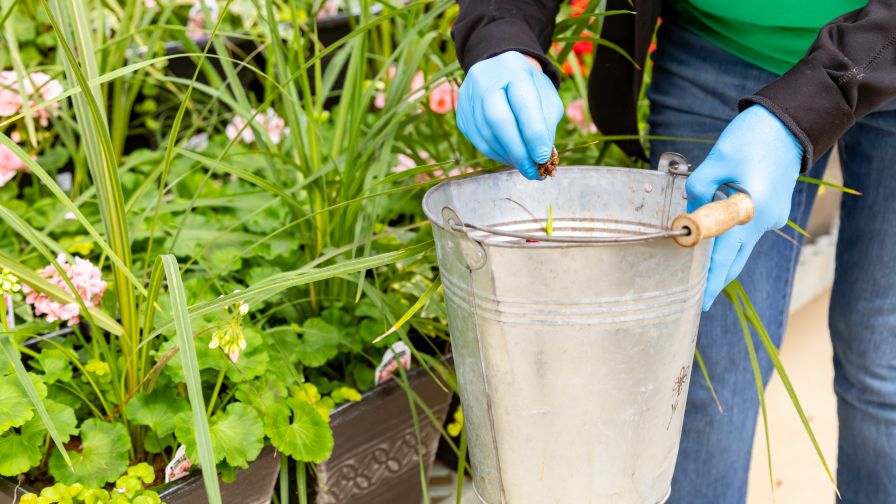
A worker in PPE equipment using pesticides | Hortica
As a Director of Safety Services at Hortica, I’m often asked about a wide range of topics. On a given day, I’m fortunate to help growers build training programs and identify risks within greenhouse structures.
However, when it comes to employee safety in our industry, pesticide safety—and the appropriate use of personal protective equipment (PPE)—remains paramount.
Your business depends on healthy plants. It also relies on healthy employees. Fortunately, you can have both by taking the right precautions.
As we head into the second half of the year, I’ve pulled together a few reminders to help you maintain a safe and healthy work environment.
Worker Protection Standard
If you buy, use, or store pesticides, comprehensive safety training is imperative—and oftentimes required.
The Agricultural Worker Protection Standard (WPS) is in place to protect greenhouse workers from occupational exposure to pesticides. This includes workers who apply pesticides and workers who are exposed to pesticides through their job duties.
While you’ll find several key reminders in this article, the WPS website should be your north star. It outlines compliance requirements, identifies businesses that must follow those requirements, and how you can select a designated representative to follow through with these regulations for your operations.
The site also offers educational safety resources you can post at your business—all available in multiple languages.
Training Requirements for Your Employees
The WPS offers an excellent reference guide to help you properly train your employees on safe pesticide handling, which includes compliance and regulatory requirements. Here’s a summary of primary actions.
- Ensure your workers are trained before performing tasks in a pesticide-treated area—and conduct annual training for all workers who handle and work with pesticides.
- Present training using EPA-approved materials either orally from written materials or audio-visually.
- Trainers must be certified applicators, have completed an EPA-approved train-the-trainer program, or be designated by the State or Tribal pesticide enforcement agency.
- Training must be delivered in a manner the employees can understand. The trainer must be present and respond to questions.
- Maintain training records at your business for two years from the training date for each worker and handler required to be trained.
Separate from the pesticide safety training, employers must inform workers and handlers where to find safety posters, application information, safety data sheets, and decontamination supplies on the worksite.
Use Appropriate Personal Protective Equipment (PPE)
PPE is essential for shielding your employees when handling pesticides. It serves as a barrier against inhalation and skin contact.
Remember, you’re the eyes and ears of your business. Make sure your employees wear the required PPE listed on the chemical label or safety data sheet (SDS) whenever they mix, apply, or dispose of chemicals.
Make it easy for your employees by keeping a readily accessible supply of PPE. Examples include:
- Respirators
- Chemical-resistant aprons, footwear, headgear, and suits
- Coveralls
- Gloves
- Protective eyewear
Your PPE is also only as good as its care. Train your staff on use, care, and replacement time. A regular maintenance schedule can help.
During training, remind your team to avoid touching their face, mouth, or nose while working with pesticides—especially if they’re wearing gloves that might be contaminated.
Any clothing or PPE used during application is exposed to chemicals. After handling pesticides, employees should:
- Thoroughly wash their hands with soap and water
- Discard contaminated clothing or wash it separately from other laundry
Review Symptoms of Pesticide Exposure
As part of your employee training, review symptoms of pesticide exposure. The sooner you can identify the problem, the sooner you can get the necessary medical treatment. Symptoms may include
- Rashes
- Tender nose
- Headache
- Sore throat
- Watery eyes
- Vomiting
Train your employees on how to respond to exposure, which can include:
- Reporting incidents
- Administering first aid
- Contacting poison control and emergency services
Follow Pesticide Safety Guidelines
Now that you’ve provided some basics for employee safety when handling pesticides, let’s examine safety procedures for the chemicals themselves. This includes proper labeling, application, storage, and cleanup.
Read and Follow Pesticide Label Instructions
Pesticide labels contain crucial information for safe use, including instructions for mixing, diluting, and applying the product. It’s your roadmap for safe use. Follow these instructions to help ensure safety and effectiveness.
Labels provide first-aid information, storage and disposal guidelines, and signal words indicating the level of hazard:
- Danger: Extremely harmful
- Warning: Moderately harmful
- Caution: Slightly harmful but may cause illness
Document Pesticide Application
It’s important to keep detailed records that include:
- Applicator’s name
- Product names
- EPA registration numbers
- Location and description of treated areas
- Crops treated
- Method of application
- Restricted entry intervals (REIs)
- Application dates and start/end time of application
- Application rates
- Amounts applied
This documentation helps track usage, identify potential issues, and demonstrates compliance with regulations. Refer to your state’s pesticide requirements to determine if additional items are required to be included in your application records.
Plan for a Possible Spill
Despite precautions, spills can still occur. Develop a spill plan with detailed instructions on ventilation, cleanup, disposal, and decontamination. Address spills promptly using the three Cs:
- Control: Shut off ignition sources, secure the container, and prevent further spillage
- Contain: Spread absorbent material around the spill, working inward
- Clean: Collect and dispose of absorbent material and contaminated items according to local regulations
Clean and Maintain Equipment
Regular maintenance of spraying equipment reduces the risk of leaks or malfunction. Promptly repair or replace damaged equipment, especially hoses, nozzles, and fittings. Thoroughly clean and flush equipment to prevent cross-contamination and ensure accurate future applications.
Store Pesticides Properly
Follow label instructions for proper storage and take into account additional risks such as fire, flood, or severe weather. Comply with federal and state regulations for storage, especially for portable and stationary containers. Notify your local fire department about the types and locations of stored pesticides to aid in possible emergency response.
Dispose of Pesticides in a Safe Manner
Never dispose of pesticide containers without following label directions and local regulations. Improper disposal can contaminate soil, groundwater, and surface water, leading to environmental damage and legal liabilities. Avoid burning or incinerating chemical containers, as the fumes are toxic and can widely spread. Contact your local Department of Natural Resources (DNR) for state-specific disposal guidelines.
Pesticides will always be commonplace throughout the industry. By following guidelines, you can help minimize the risks associated with pesticides, while protecting your employees, your customers, and your crops. If you have any questions specific to your operation, it’s always best to talk with a local expert or refer to WPS guidelines.

